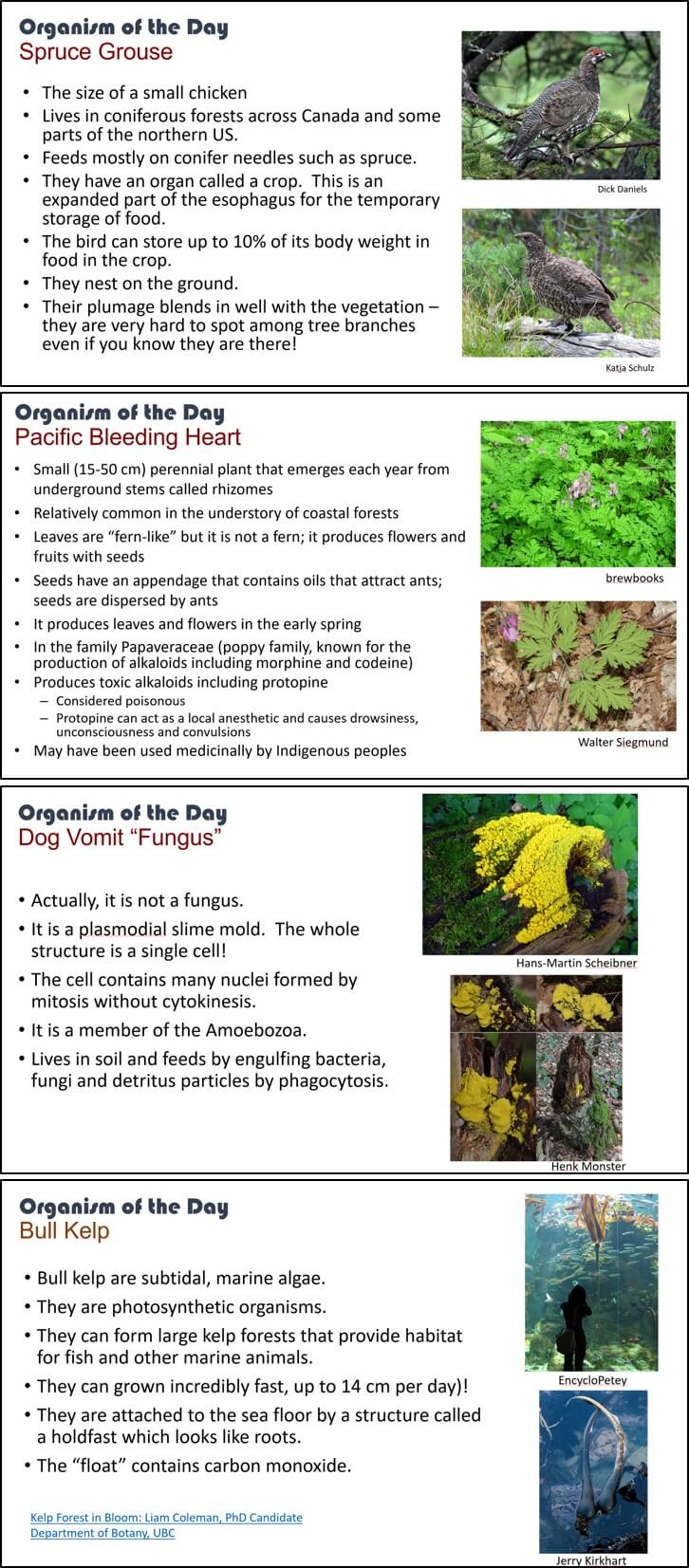
Brett Couch starts most of his BIOL121 classes with a 1-2-minute presentation of some fun facts about an organism that can be found around UBC or coastal British Columbia. In addition to introducing students to various local species, the organism of the day activity “is meant to be fun and to also help students see me as more accessible – I do my best to mimic a few bird calls (juvenile barred owls and spruce grouse) and I provide personal anecdotes about some of the organisms.”
Below, Brett describes what motivated him to feature an organism of the day, how the activity has morphed over time, and what he’s learned along the way.
What was your motivation behind using this activity?
My initial motivation for beginning my classes with an organism of the day was to introduce students to some of the biodiversity (fungi, algae, plants and animals) they may see around campus or the lower mainland. I want students in my first-year biology classes to finish the course with an awareness of local biodiversity and to begin noticing the biological world around them.
I have continued to develop and refine this component of my class. I have taken opportunities to pair the fun facts with the specific concepts covered in a particular class. For example: sexual dimorphism in birds prior to a class on sexual selection; interfertility and gene flow among wolves, coyotes and domestic dogs prior to the discussion of species concepts; adaptations in understory plants; the smelly adaptation in skunk cabbage as a way of attracting pollinators.
I am now using this activity as a vehicle to introduce some Indigenous knowledge into my classes. As part of the fun facts, I highlight historical and contemporary uses and value of the organisms to local Indigenous peoples.
How is this activity implemented in the course?
Generally, the “Organism of the Day” is presented as a short 1-2 minute introduction at the beginning of each class, although the activity in my first class is longer and paired my land acknowledgement.
The first class features western red cedar, and I have worked to present to students the value of the plant to Indigenous peoples beyond simple material use and have students do an in-class activity where they consider the biology of the plant, the materials uses and other ways the organism can be and is valued. I begin this activity by introducing some basic factual information on the biology of the organism and link this to some of the concepts that will be covered in the course (asexual and sexual reproduction, adaptations and ecology). I then present a quote from the Haida artist, Bill Reid, on the importance of western red cedar to costal Indigenous peoples:
“Oh, the cedar tree! If mankind in his infancy had prayed for the perfect substance for all material and aesthetic needs, an indulgent god could have provided nothing better.” Bill Reid 1984
Individually, students write down some of their ideas on the value of western red cedar. Students then work in groups to discuss their ideas on the value of the organism. As a group they fill in a handout where they present the results of the discussion on the value of western red cedar and notes on how they would recognize the plant if they saw it again. I wrap up the activity with a presentation of some of the material and cultural uses of cedar to the Musqueam, and as a focal species for Haida forest management plans and have students consider the number of human lifetimes it takes to replace ancient trees in the landscape following harvest.
As a small motivation to review the organisms presented in class, I add questions on midterms related to the organism of the day. These are generally bonus questions but are graded for quality and accuracy.

What impact has this activity had on students or the course?
On the final exam, I ask students about something they learned in the course that surprised them and to explain why. Students often refer to the organism of the day in general or specific organisms that they found interesting. On teaching evaluations and on the final exam students have indicated that they find this a nice way to start the class – it provides a gentle introduction rather than jumping right into the material for the day. Students have also commented that they feel “smart” being able to recognize organisms and to show off their knowledge to friends.
What advice would you give someone who might want to do something similar in their course?
Make the organisms relevant to the material and concepts covered in classes so students don’t feel that this is an add-on and not relevant to the course material. Find organisms that students may care about, are likely to encounter and that have some fun or exciting aspects. For example, students often choose to discuss the tetrodotoxins in rough skinned newts when asked about an organism of the day on exams. Put yourself out there, try bird calls and have a little fun!
Is there anything else you’d like to share?
I am happy to talk more or share materials with anyone that is interested. My email contact is: brett.couch@botany.ubc.ca
Here are some additional slides I’ve used to feature the organism of the day:
